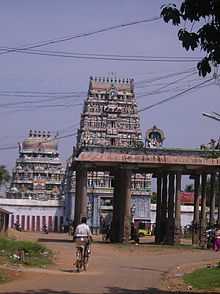Masilamaniswara Temple, Thirumullaivoyal
| Masilamaniswara Temple | |
|---|---|
 | |
 Masilamaniswara Temple Location in Tamil Nadu
| |
| Coordinates: | 13°07′N 80°07′E / 13.117°N 80.117°ECoordinates: 13°07′N 80°07′E / 13.117°N 80.117°E |
| Location | |
| Country: | India |
| State: | Tamil Nadu |
| District: | Tiruvallur |
| Location: | Thirumullaivoyal |
| Temple Details | |
| Primary Deity: | Masilamaninathar(Shiva) |
| Consort: | Kodiyidai Nayagi(Parvati) |
| Temple Tank: | Manasa Pushkarani |
| Temple Tree: | Mullai Kodi |
| Architecture and culture | |
| Architectural styles: | Dravidian architecture |
Vada Tirumullaivayil or Masilamaniswara Temple is a Hindu temple dedicated to Lord Shiva located in the Chennai-Avadi road, India. The temple is incarnated by the hymns of Thevaram and is classified as Paadal Petra Sthalam. The temple is incarnated by the hymns of Sundarar,[1] Ramalinga Swamigal and Arunagirinathar.
History
In ancient times, the forest surrounding Tirumullaivayil was occupied by two Kurumbars named Vanan and Onan. King Thondaiman who was the emperor there tried to end the atrocities by waging a war against them. En route to the war, his elephant's leg was surrounded by Mullai(lily) shrebs. The king while cutting those found blood oozing out of it and later found that it is the Lords blood. He then ordered to build a temple for Masilmaninathar.
It is believed that the Lord supported him in destroying the Kurumbars by sending the Nandi. The Nandi in Shiva temples face the lord, but the Nandi in this temple faces east ward against Lord Shiva. Also this is one of the few temples where the positions of the Lords are interchanged. This is believed to be because of the urgency in providing darshan(view) to the king.
Kodiyidai Nayagi
The powers of the consort deity, Parvathi is classified as under.
- Tiruvudai Amman, Melur: Icha Shakthi
- Kodiyidai Amman, Tirumullaivayil: Kriya Shakthi
- Vadivudai Amman, Tiruvotriyur: Gnana Shakthi
Festivals
Every year in the month of Chittirai(Mar-Apr), on Sadaya nakshatra(Sadayam star), the Santhana kappu is refurbished with Veru kappu. This is believed to be the treatment for the blood that oozed out of the deity because of the king's attack.
Gallery
-

Outer view of the temple
References
- ↑ History of the Tamils: from the earliest times to 600 A.D. P.26. P. T. Srinivasa Iyengar